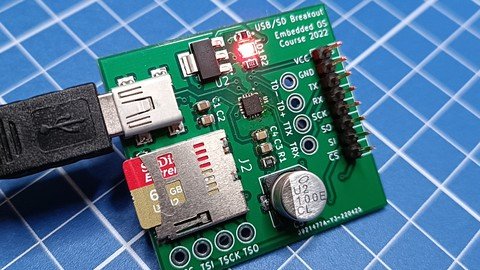
Published 5/2023
MP4 | Video: h264, 1280×720 | Audio: AAC, 44.1 KHz
Language: English | Size: 5.93 GB | Duration: 10h 48m
Hands-on Embedded Operating System Development from the ground up
What you’ll learn
Learn how to build an embedded system from the ground up on the bench. This will give you a great insight into the target platform, but is not mandatory
Learn how to program a microcontroller from scratch by setting up wiring, clocking, connecting the programmer, and flashing binary applications to the chip
Get a deep insight into what an operating system is, when you need one, and how it works on embedded platforms
Understand Kernels, Multitasking, Context Switching, Scheduling, Critical Sections, and Task Synchronization from a practical perspective
Understand CPU Architectures in general and how to choose a target CPU. Deep understanding of the MIPS32 Arch internals, like Registers and Memory Layout
Programming of Advanced Applications for the Microchip PIC32 (MIPS32) microcontroller
Develop Board Support Packages (BSP) for a Target Platform
Deep and practical understanding of data communication over the SPI and I2C busses, as well as serial communication via UART modules (including USB-to-Serial)
Learn how to develop a Preemptive and Cooperative Kernel based on CPU-specific assembly code for Task Context Switching
Learn how to provide efficient internal services for Time, Task, and Memory Management
Learn how to create Inter-Process Communication (IPC) with Mailboxes and Message Queues
Get a deep understanding of – and learn how to implement – Real-Time Constraints in order for an operating system to be considered an RTOS (Real-Time OS)
Understand the Priority Inversion problem and learn how to implement specific countermeasures
Learn Device Driver development. We will develop drivers step by step for our Target Platform’s peripherals, such as the display and the MicroSD card
Interfacing User Application to the OS
Understand how to write a binary image to the Target Platform’s Program Flash at runtime, and create a USB/UART Bootloader
Learn how to make a Porting of the OS, making it executable on different CPU Architectures
Understanding of the Target Platform’s Electrical Schematic and PCB Layout (optional)
Requirements
Basic C programming skills are recommended but not mandatory. The code implementation will be performed hands-on, with explanation in real-time. No particular prior knowledge is required. If you have any questions, simply drop me a message: I will answer to you.
Description
In this course you will learn how to create an Embedded OS, really from the ground up. You will be guided step by step in the creation of each and every technical software module composing an embedded operating system, as well as in the development of your own target device on the bench (optional: you can use a free simulator or a ready-to-use Starter Kit), starting with basic electronic components and an industry-standard processor.You will learn how to create device drivers step-by-step for real hardware components like displays, SD card storage, Wi-Fi, Inertial Movement Units (IMU, i.e. accelerometer and gyroscope), USB communication, analog Joysticks, thermal camera modules and more.By the end of this course you will master system-level programming in the assembly and C languages, as well as the technical processes governing the interaction between CPU and memory. Thanks to the numerous hands-on experiences and practical demonstrations, you will develop the ability of gaining full control on the machine by manipulating CPU registers, stack, instruction pointer, return addresses, and much more. At the end of the software development part, you will learn how to create a porting to another architecture, like x86.Although the hardware development part is optional, if you have access to an electronics lab you will also develop the ability of prototyping your circuit, designing and assembling your own target PCB (Printed Circuit Board).
Overview
Section 1: Set, Ready, Go!
Lecture 1 Course Presentation
Lecture 2 Motivation
Lecture 3 Environment Preparation
Section 2: Base Electrical Circuit
Lecture 4 Prototype Design
Lecture 5 CPU Breakout Board
Lecture 6 The First Program
Lecture 7 Simulating Without Hardware
Section 3: Operating System Basics
Lecture 8 Introduction to Tasks
Lecture 9 Introduction to Multitasking
Lecture 10 Shared Resources
Lecture 11 Task Switching
Lecture 12 Kernels
Lecture 13 Schedulers
Lecture 14 Critical Sections
Lecture 15 Deadlocks
Lecture 16 Introduction to Task Synchronization
Lecture 17 System Tick
Section 4: Target Platform
Lecture 18 CPU Architectures
Lecture 19 Choosing the right CPU
Lecture 20 MIPS32: CPU Registers
Lecture 21 MIPS32: Memory Layout
Lecture 22 The PIC32 Microcontroller
Lecture 23 Our Board VS Microchip’s StarterKit
Section 5: Interrupts
Lecture 24 Interrupts Overview
Lecture 25 ISRs: Interrupt Service Routines
Lecture 26 Interrupt Latency and Interrupt Response
Lecture 27 Interrupts in our Operating System
Lecture 28 Testing Interrupts with the Software Interrupt
Section 6: BSP (Board Support Package)
Lecture 29 BSP Overview: What is the Board Support Package
Lecture 30 Setting up the System Timer
Lecture 31 Setting up the System Tick Interrupt
Lecture 32 Setting up the system’s LEDs
Lecture 33 Testing LEDs: Flashing an S.O.S.
Lecture 34 UART: Explanation and Setup
Lecture 35 Testing the UART: Ping-Pong with a PC
Lecture 36 SPI: Explanation and Setup
Lecture 37 Testing the SPI: Ping-Pong with an Arduino
Section 7: Kernel
Lecture 38 The Base Infrastructure
Lecture 39 Implementing Tasks and TCBs
Lecture 40 Implementing Stack Management
Lecture 41 Implementing Context Switching in Assembly
Lecture 42 Task Management
Lecture 43 Implementing the Scheduler
Lecture 44 Starting the Operating System
Lecture 45 Time Management
Section 8: Event Management
Lecture 46 Event Management Concept
Lecture 47 Data Structures for Event Management
Lecture 48 Event Creation and Response
Section 9: Task Synchronization
Lecture 49 Implementing Mutexes
Lecture 50 Implementing Semaphores
Lecture 51 Priority Inversion Avoidance
Section 10: ITC (Inter-Task Communication)
Lecture 52 Implementing ITC with Mailboxes
Section 11: OS Development Project
Lecture 53 Download the Complete OS Sources
From embedded developers to hobbyists and enthusiasts who are willing to create their own Operating System.,This course is hands-on: you will be guided step by step through the creation of a working Operating System, from the ground up.
Password/解压密码www.tbtos.com